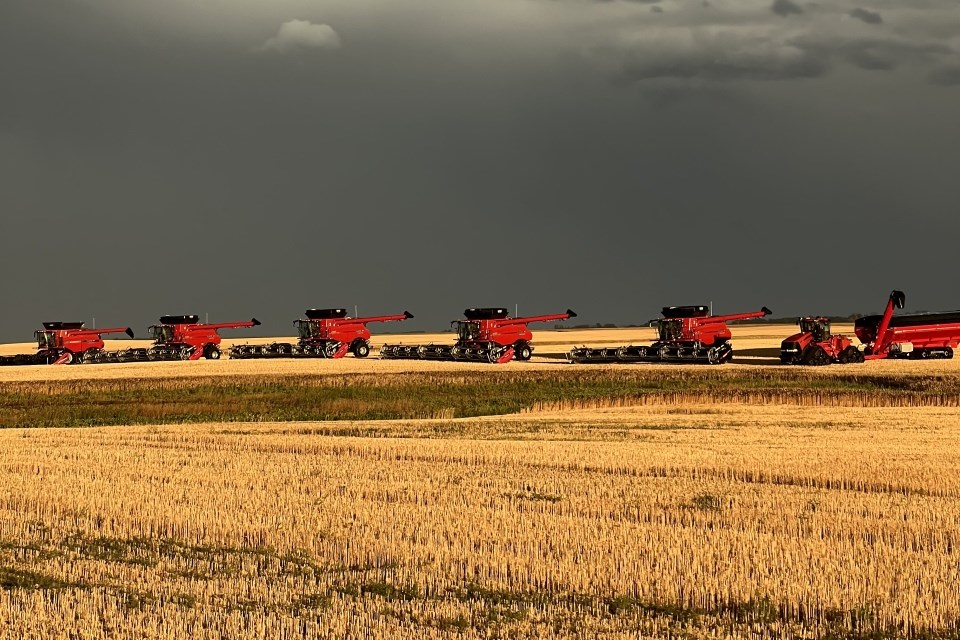It’s magic time in Saskatchewan.
Time for harvest and, thanks to crop development science, this can usually happen a little earlier than it did three or four decades ago.
I really can’t tell you exactly why I get excited about the annual “bringing in the sheaves” thing. I don’t come from a farming background, but growing up in Saskatchewan has always meant you are no more than one half-degree separated from those who are. It’s a fact of life in this province.
We can discuss coal, oil, uranium and other wonders of the earth on another day. Right now, let us embrace these fields of wheat, barley, oats, canola, lentils, flax and corn and … well, you know. It’s the stuff our agricultural friends can bring off the fields in grand quantities to hopefully sell on a solid scale within a growing global market after transporting it to elevators and ports.
Saskatchewan has always been beholden to, and maybe always will have to rely on, agricultural production to make ourselves whole. We can fill gaps when the weather and land refuse to co-operate, but for the most part, when the crops go down, so do we, to some extent.
Growing up in Saskatchewan with a retail background, we learned early how reliant and reliable the farming community was for our own self-interest.
Good crop years meant good sales and pork chops or roast beef on the table. Poor crop year? Well, it’s time for canned baked beans on toast with a side of sliced tomato.
We lived on a corner lot in the town, so our only next-door neighbour was a farmer, Walter Magnusson. We celebrated with him and his son Ron, who was about the same age as my older sister, when crops came in strong, well graded and included a good price point. One year he hit the jackpot with flax and the next-door home got a major renovation and a brand new Ford Edsel appeared in their natural dirt driveway. (Well, sometimes errors are made with celebratory selections, i.e. the Edsel).
The renovations were made but well noted was the fact there was no fence put up between our properties. I was still able to chase my errant baseball into their driveway or backyard with ease and no debates. Our fence did not extend past our share of the back lane and the north side that bordered a fairly busy avenue. And that’s how it pretty well went right around town. If a fence was built, it was low and navigable.
Let’s go back to the harvest basics.
In small-town Saskatchewan, it isn’t just about the field crops — it is also garden production.
Our family were bad gardeners, but we didn’t have to worry, other neighbours and friends took care of that. With both parents being in retail sectors six days of the week, there was very little in the form of gardening, although our mother did take a big stab at it for a couple of years when she became the owner of a lot on the other side of town. We planted potatoes and peas and carrots … all the traditional stuff. My sister and I hated weeding among the mosquitoes and other bugs and growths, especially when we discovered that this piece of town land was not prone to fruitfulness. Oh well, we tried.
In the meantime, friendly gifts of home-jarred dill pickles from the Yurach and Pidkowich families just down the street filled our gardening gap. Mrs. Rudneski’s raspberry with rhubarb pies were a wonderful treat. In fact, I sometimes joked to my friend Vern, her son, that the only reason he was my friend was due to his mother’s baking prowess and not much the cause of his personality or character. His mom added to a positive family picture with her attitude and kitchen expertise.
I have ridden on a few tractors and horses, but reluctantly admit that I never hiked up onto a combine until I was in my 50s and then it was onto an antique model that moaned and groaned around the field while I interviewed the farmer who was happy to be bringing in a wonderful crop of oats as a donation to a local community cause, if I remember correctly. That’s another thing farmers do, you know.
I wouldn’t even know how to approach a current combine. How do you seek permission to climb aboard? Do you need a secret password to appease A.I. functionaries? How would you climb aboard if your left knee isn’t as reliable as it used to be? It seems to be a long way up there. Are hydraulics involved? A PhD in agriculture?
Oh well, I marvel at the machinery and, for sure, the quality of the crop as I drive by on any RM road or the highway, and take in the beauty of my province in full bloom.
I see the lights on the machinery as the harvest wends its way into the night, or grab a gaze as the team takes a breath and does a little rehydrating in a full-blown sun-filled day. I will continue to smile at local harvests until I’m done, and never apologize for being from this grand province that more than fulfils its duty to feed the world while providing these special magical moments for those of us who live here.
It doesn’t matter what size or how new or old the equipment is. We know the land itself has produced wonders over the years as well as heartbreak. It’s all part of the unfolding scenario we call life in Saskatchewan.
So to those farmers, our agricultural specialists who are “bringing in those sheaves” using whatever means … thank you.
It can’t be easy, but it’s definitely appreciated, locally and globally. A vital job done well needs to be celebrated.



